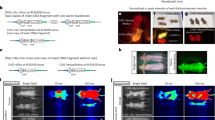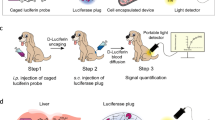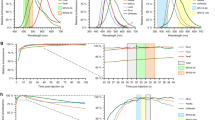Abstract
The luciferase reporter gene is a useful tool for determining the efficacy of transfection of plasmid DNA and adenovirus-mediated gene transfer in vivo. However, we report here that the haemoglobin present in tissue samples can mask the detection of the luciferase activity and lead to underestimation of the luciferase levels. We evaluated the degree of interference in different organ samples of mice and investigated the possibilities for removal of haemoglobin from tissue samples by: (1) perfusion of the whole animal; (2) different hypotonic treatments lysing preferentially red blood cells; and (3) chromatographic separation. Removal of haemoglobin resulted in significantly improved detection of luciferase activity from tissue samples. The results indicate that the luciferase activity determined in tissue samples may not reflect the actual level of reporter gene expression, if contaminating blood is not taken into consideration.
This is a preview of subscription content, access via your institution
Access options
Subscribe to this journal
Receive 12 print issues and online access
$259.00 per year
only $21.58 per issue
Buy this article
- Purchase on Springer Link
- Instant access to full article PDF
Prices may be subject to local taxes which are calculated during checkout





Similar content being viewed by others
References
Thierry AR et al. Systemic gene therapy: biodistribution and long-term expression of a transgene in mice Proc Natl Acad Sci USA 1995 92: 9742–9746
Fortunati E et al. In vitro and in vivo gene transfer to pulmonary cells mediated by cationic liposomes Biochim Biophys Acta 1996 1306: 55–62
Hara T, Tan Y, Huang L . In vivo gene delivery to the liver using reconstituted chylomicron remnants as a novel nonviral vector Proc Natl Acad Sci USA 1997 94: 14547–14552
Li S, Huang L . In vivo gene transfer via intravenous administration of cationic lipid-protamine-DNA (LPD) complexes Gene Therapy 1997 4: 891–900
Liu F, Qi H, Huang L, Lui D . Factors controlling the efficiency of cationic lipid-mediated transfection in vivo via intravenous administration Gene Therapy 1997 4: 517–523
Barron LG et al. Effects of complement depletion on the pharmacokinetics and gene delivery mediated by cationic lipid-DNA complexes Hum Gene Ther 1998 9: 315–323
Goula D et al. Polyethylenimine-based intravenous delivery of transgenes to mouse lung Gene Therapy 1998 5: 1291–1295
Huard J et al. The route of administration is a major determinant of the transduction efficiency of rat tissues by adenoviral recombinants Gene Therapy 1995 2: 107–115
Yei S et al. Adenovirus gene transfer for cystic fibrosis: quantitative evaluation of repeated in vivo vector administration to the lung Gene Therapy 1994 1: 192–200
Colin M et al. Liposomes enhance delivery and expression of an RGD-oligolysine gene transfer vector in human tracheal cells Gene Therapy 1998 5: 1488–1498
Colin M et al. Cell delivery, intracellular trafficking and expression of an integrin-mediated gene transfer vector in cultured tracheal epithelial cells Gene Therapy 2000 7: 139–152
Harbottle RP et al. An Arg-Gly-Asp/oligolysine peptide: a prototype construct for integrin mediated gene delivery Hum Gene Ther 1998 9: 1037–1047
Wood KV, Lam YA, McElroy WD . Introduction to beetle luciferase and their applications J Biolum Chemilum 1989 4: 289–301
Leenen PJ et al. Heterogeneity of mouse spleen dendritic cells: in vivo phagocytic activity, expression of macrophage markers, and subpopulation turnover J Immunol 1998 160: 2166–2173
Scher W, Holland JG, Friend C . Hemoglobin synthesis in murine virus-induced leukemic cells in vitro. I. Partial purification and identification of hemoglobins Blood 1971 37: 428–437
Bradford M . A rapid and sensitive method for the quantification of microgram quantities of protein utilizing protein-dye binding Anal Biochem 1976 72: 248–254
Kajiyama N, Nakano E . Isolation and characterization of mutants of firefly luciferase which produce different colors of light Protein Eng 1991 6: 691–693
Acknowledgements
This work was supported by grants from the ‘Institut National de la Santé et de la Recherche Médicale’ (INSERM) and from the ‘Association Française de Lutte contre la Mucoviscidose’. We thank Dr A Pavirani of Transgene SA (Strasbourg, France) and Dr M Themis (Imperial College, London) for providing AdMLPLuc and Dr D Gruenert (Gene Therapy Core Center, USA) for the 56FHTE8o− cell line. CC is funded by the Muller Bequest/CF-Trust, the MRC and the March of Dimes Birth Defects Foundation. HS was supported by the Deutsche Forschungsgemeinschaft.
Author information
Authors and Affiliations
Rights and permissions
About this article
Cite this article
Colin, M., Moritz, S., Schneider, H. et al. Haemoglobin interferes with the ex vivo luciferase luminescence assay: consequence for detection of luciferase reporter gene expression in vivo. Gene Ther 7, 1333–1336 (2000). https://doi.org/10.1038/sj.gt.3301248
Received:
Accepted:
Published:
Issue Date:
DOI: https://doi.org/10.1038/sj.gt.3301248
Keywords
This article is cited by
-
Comparison of ex vivo bioluminescence imaging, Alu-qPCR and histology for the quantification of spontaneous lung and bone metastases in subcutaneous xenograft mouse models
Clinical & Experimental Metastasis (2024)
-
In vivo fluorescence imaging: success in preclinical imaging paves the way for clinical applications
Journal of Nanobiotechnology (2022)
-
Reporter gene comparison demonstrates interference of complex body fluids with secreted luciferase activity
Scientific Reports (2021)
-
A plug-and-play platform of ratiometric bioluminescent sensors for homogeneous immunoassays
Nature Communications (2021)
-
The potential application of a transcriptionally regulated oncolytic herpes simplex virus for human cancer therapy
British Journal of Cancer (2014)



